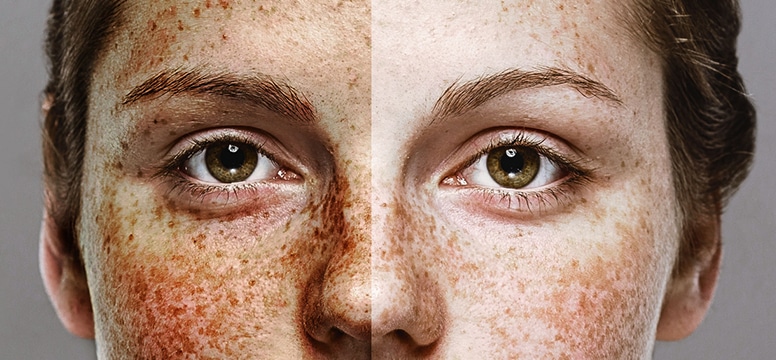
How can you tell if you have sun damage?
Sun damage, the phrase used to describe skin damage caused by excessive exposure to the sun’s ultraviolet (UV) rays, affects many people around the globe. Unfortunately, unless you protect your skin using clothing, hats, and proper UV-blocking sunscreen, your skin will inevitably be exposed to these harmful rays anytime you are in the sun. While some exposure to UV rays is not harmful to you, over time, you could do serious damage to your skin–especially if you have sensitive skin.
To determine whether your skin has been overexposed to UV rays, you can check with your dermatologist. Your dermatologist will evaluate your skin, looking for signs of sun damage. Your dermatologist will also ask you a series of questions to learn more about you and get an idea of how much sun exposure your skin may have had throughout your life.
What does sun damage on the skin look like?
The most common symptoms of sun-damaged skin include:
- Sunburn
- Redness
- Wrinkles
- Eye wrinkles
- Lip wrinkles
- Sun spots
- Age spots
- Skin discoloration
- Freckles
- Skin tone changes
If you’re suspicious of an area of your skin and think you may have sun damage, visit your dermatologist for a full skin evaluation. Your dermatologist can also run a skin cancer screening to ensure that your sun damage has not resulted in any malignant areas of skin.
Can sun damage cause white spots on the skin?
Some people will notice small white skin spots that appear to be sun damage to the skin. While this may be a response to sun damage, white spots on the skin could also indicate a different dermatological condition. If you notice any changes to your skin (including brown, black, red, pale, white, or tan patches or spots appear on your skin), get in touch with your dermatologist. Your doctor may want to have you come in for an evaluation if a skin condition or skin damage is suspected.
What can a dermatologist do for sun damage?
Depending on the extent of your skin damage, your dermatologist may recommend one or more of the following skin rejuvenation treatment options:
- Microdermabrasion for sun-damaged skin
- Laser skin rejuvenation for sun damage
- Chemical peeling for sun spots
- Prescription skin medications
- Cryotherapy for sun damage
Can you reverse sun damage?
Sun damage can be reversed or improved by a dermatologist in some cases. The above dermatology treatments for sun-damaged skin can often restore a more youthful look and feel to your skin. However, it’s important to make lifestyle changes to avoid repeated sun damage after your treatment. Some of the ways you can avoid sun damage include:
- Wear UV-resistant sunglasses
- Wear protective clothing (especially in the afternoon)
- Wear sunscreen every day
In addition to these top three rules for avoiding sun damage, you can also try to avoid being outdoors for long periods, especially between the hours of 10:00 am and 3:00 pm–the peak sunlight hours. During this time frame, the sun gives off more UV rays than any other time of the day.
How long does sun damage take to appear?
After you’ve been out in the sun all day, will you notice sun damage? The answer is yes and no. Yes, if you’ve been outside in the sunlight without the proper sunscreen and protective gear, your skin will have some damage to it. The sun dries out your skin and removes its natural oils. In worse cases, the sun’s UV rays may cause burning to the skin or long-term damage. However, these long-term effects cannot be seen right away.
Instead, the long-term effects of sun damage are seen years and years in your future. Decades could pass without you noticing the harm that has been done to your skin’s surface. Suddenly, after years, you could notice age spots or other signs of sun damage that is the result of years of UV ray exposure and damage.
Short-term Sun Damage Symptoms
In the hours or days after sun UV ray exposure, you may notice:
- Sunburn
- Redness
- Dry skin
- Flaky skin
- Wrinkles
- Scaly texture
Long-term Sun Damage Symptoms
After many years of sun damage, you may notice:
- Tiny bumps
- Pink, yellow, brown, or red patches of scaly skin
- Premature skin aging
- Fragile blood vessels
- Deep lines or wrinkles
- Thick, leathery skin texture
If you notice any of these long-term sun damage symptoms, it’s important to speak with a dermatologist who can rule out skin cancer and help you find solutions for reversing your skin’s sun damage.
Is it too late to prevent sun damage?
Sun damage gets worse and worse as you expose the skin to the sun’s harmful UV rays. So, it’s never too late to prevent further damage to your skin. Take care in following directions given to you by your dermatologist that will help you avoid skin damage in the future. You can also follow these three helpful tips to prevent sun damage:
- Wear sunscreen every day
- Wear sunglasses that are UV-resistant
- Wear protective gear
What is the best treatment for sun-damaged skin?
Because everyone’s skin is different, it’s important to speak with your dermatologist during an office visit to get the best sun damage treatment for your skin type and concerns. Some of the many popular sun damage reversal options that a dermatologist can offer include:
- Microdermabrasion
- Laser skin rejuvenation
- Chemical peels
- Sun damage-specific medications
- Cryotherapy
Schedule a Skin Treatment Consulation
Rendon Center can address all of your medical and aesthetic dermatology needs, including sun damage treatment. Our combination of innovative technology and experience translates to superior, quality care. Call 561-750-0544 or fill out the form on this page today to schedule a consultation.

